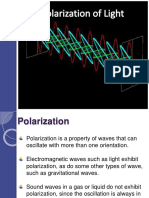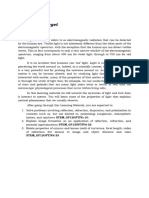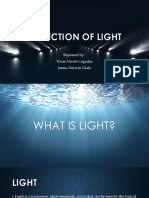Chapter 13
Chapter 13
Uploaded by
Rea Jane PimentelCopyright:
Available Formats
Chapter 13
Chapter 13
Uploaded by
Rea Jane PimentelCopyright
Available Formats
Share this document
Did you find this document useful?
Is this content inappropriate?
Copyright:
Available Formats
Chapter 13
Chapter 13
Uploaded by
Rea Jane PimentelCopyright:
Available Formats
Scattering and
Polarization
Light waves can scatter
off water droplets, dust
particles and other
molecules in air
Some wavelengths in white
light scatter more than
others (Rayleigh scattering)
This is why the sky is blue
The polarization of light
refers to the plane in
which the waveform and
electric force field lies
Most light is unpolarized
The waveforms and electric
force field on a given ray
keep jumping around in
orientation while always
perpendicur to the ray
Scattered or reflected light
is polarized in particular
planes
Polaroid sunglasses can
block out polarized light
from sky and ground
3D movies & other
applications of polarizers;
1
http://icamconferences.org/iv
an_talk/
Video synchronized with the
ppt.-file of the presentation
Reminder: HW #11 due on
Thursday
Today: Finish Ch.13 material
Thursday: Chapter 14+
Lab Tour (optional):
after the class time on
Tuesday, December 8,
4:30-6PM.
Computers & cell
phones allowed in
class today!!!
Be TRANSMITTED
laser aimed at water or
glass
Be REFLECTED
specular reflection of light
by a mirror
diffuse reflection of the
light in this room off all the
other students
reflection is re-radiation of
light by the electrons in
the reflecting material
Be ABSORBED
Cyan light shining on a red
apple is absorbed by
electrons in the apple
Something new!!
A light wave shining on
molecules in the air or
plastic or other
transparent materials
can be
SCATTERED
Light ray moves over to
the side in all directions
rather than forward,
backward or being
absorbed.
Intensity of the scattered
light can depend on
wavelength
The shorter the wavelength,
the more light is scattered
blue is scattered more than
red.
this is why the sky is blue and
sunsets are red. (Fig. 13.1)
Think of white light
from sun as a mixture
of R, G and B
Blue is scattered the
most so sky looks
blue when we look
away from the sun
For same reason sun
looks yellow (red +
green)
More atmosphere
allows next shortest
wavelengths (green)
to scatter so sunset
looks red
Intensity inversely proportional to
4
Light waves with longer wavelength
scatter more
But why blue and not violet?
Spectral response of cones
in typical human eye
Our eye sensitivity to the
blue color is much stronger
than that to violet!
We perceive the deep
waters being of blue color
for the same reason!
Earth
Atmosphere
Rays from Sun
(not scattered)
White or yellow
A. Because of
scattering of short-
wavelength blue light
coming from the Sun;
B. Because of light
absorption similar to
that in color filters;
C. A & B
D. Because of
dispersion and total
internal reflection;
E. None of the above;
D. Black
A. Red;
B. White;
C. Blue;
E. Yellow;
A. Red;
B. Green;
C. Blue
D. Black;
E. White;
Larger particles scatter red as well
as blue and hence look white.
Dust or smoke
Clouds;
Milk;
Colloidal suspension
There are many
other types of
scattering
A. Because of light
absorption similar to that
in color filters;
B. Because of scattering
of blue and green light
and only red light
coming to our eyes;
C. Because of its
polarized nature;
D. Because of
chromatic & spherical
aberrations;
E. None of the above;
Secularly reflected light blocked using a polarizer (Polaroid film)
http://en.wikipedia.org/wiki/File:Mudflats-polariser.jpg
Speed of light in empty space is c = 186,000 miles/sec
= 3 x 10
8
meters/sec
Ray
Waveform
Amplitude
(maximum height)
The intensity of the
light is proportional to
the amplitude squared.
Large amplitude
means bright light.
Low amplitude means
dim light
W
a
v
e
l
e
n
g
t
h
Light consists of electric (and
magnetic) fields moving through
space at the speed of light
The waveform can be replaced
by a set of arrows
perpendicular to the ray whose
tips lie along the waveform
Waves on a rope
Think about the waves on a rope:
Same story:
Light is polarized if the waveform
and electric force field arrows
remains in the same plane
The (green) electric force arrows
must always be perpendicular to
the ray
This is a light ray traveling in the z-
direction and polarized in the y-
direction
Here is a light ray traveling in the
same direction but polarized in
the x-direction
We will visualize the polarization in
the x-y plane, looking at rays
head-on
The green force arrows point up
and down or left and right,
stacked up behind one-another.
Here is the convention for
visualizing vertical and horizontal
polarization
x
Looking at ray "head-on" see
green arrows up & down
y
z
x
y
z
y
x
A. Vertical;
B. Horizontal;
C. Along the
light
propagation
direction (yellow
arrow);
D. None of the
above;
y
x
For unpolarized light the
plane of polarization
keeps jumping around
But the electric field
arrows remain
perpendicular to the ray
(direction of travel of the
wave)
We visualize this in the x-y
plane (looking into the
ray) as shown at right
The many crossed double
sided arrows are the
symbol for unpolarized
light
See Physics 2000
x
y
z
electric force arrows
jump around while
remaining perpen-
dicular to the ray
wave travels in
z-direction
http://www.colorado.edu/physics/2000/index.pl
The special angle of
incidence is where the
refracted ray and reflected
ray are perpendicular to each
other
This is called Brewster's angle
To understand, imagine the
electric force arrows of the
incident unpolarized light to
be decomposed into two
perpendicular polariza-tions
the first polarization is
horizontal (force arrows are
parallel to the flat reflecting
horizontal surface and
perpendicular to the ray)
in the 2nd (Fig. 13.5), the
arrows are perpendicular to
both the ray and the
horizontal force arrows
The second polarization cannot be
sustained in the reflected ray because
the force arrows would be parallel to
that ray (impossible for a light ray)
Hence, only the horizontal polarization
survives in the reflected ray
When you wear polaroid
sunglasses they block light
polarized in the plane of your
two eyes
When your head is vertical this is
the horizontal plane
Since reflected light from the
ground or scattered light from
the sun are mostly polarized in
the horizontal plane such light is
mostly blocked
Demo with polaroid filters
The first filter blocks one
polarization and lets through the
other (perpendicular) one
The second blocks more and
more of the remaining polarized
light as its axis is rotated so as to
permit only the polarization
blocked by the first
When the axes of the two
polaroid filters at at right angles
to each other no light comes
through
Physics 2000 polarization applets
The polaroid filter works because it
has long molecules lined up parallel
to each other like hairs
Components of light with
polarization parallel to the
molecules are absorbed and
components of light polarized
perpendicular to the molecules are
absorbed and don't go through
Other demos with crossed polarizers
Third polarizer at angle in between
lets light through again
Stressed plastic between polarizers
shows colors which reveal the
stress patterns
Use color filters to
make the left and
right eyes perceiving
slightly differen
images
http://www.3dmovie
s.com/
In 3D movies:
A. Left eye sees the same
as the right eye;
B. Left eye sees the
inversed image
compared to that
seen by the right eye;
C. The images seen by
the two eyes are
slightly different and
taken from different
angles.
You might also like
- 06-237463-001 - Aegis 2.0 Manual - AADocument102 pages06-237463-001 - Aegis 2.0 Manual - AALUIS FELIPE LIZCANO MARIN50% (2)
- Why Is The Sky BlueDocument7 pagesWhy Is The Sky BlueY D Amon Ganzon100% (1)
- Arinc 429-16Document563 pagesArinc 429-16James V. Mullins100% (6)
- Project PDFDocument21 pagesProject PDFJohn Wayne100% (1)
- Light - NotesDocument4 pagesLight - Notesadaa.baaniNo ratings yet
- Classwork UbeCHZZ51Y Grade7LightandSoundResources 1Document73 pagesClasswork UbeCHZZ51Y Grade7LightandSoundResources 1moudgalya.kamavarapuNo ratings yet
- Physics Project File: PolarisationDocument12 pagesPhysics Project File: Polarisationanon_558683965No ratings yet
- L-2B The Human EyeDocument37 pagesL-2B The Human EyedancelikeangelNo ratings yet
- Light LPDocument8 pagesLight LPkevalharsoda7No ratings yet
- Angel PDF PhyisicsDocument5 pagesAngel PDF PhyisicsJay CalladaNo ratings yet
- Light WavesDocument19 pagesLight WavesDejaunae LawsonNo ratings yet
- SHS PS Q2 LP5Document11 pagesSHS PS Q2 LP5Marion Nico EspiloyNo ratings yet
- Francis AssignmentDocument4 pagesFrancis Assignmentfrancissesay955No ratings yet
- The Human Eye and the Colourful World L3-4Document27 pagesThe Human Eye and the Colourful World L3-4vivek.singhNo ratings yet
- Optics 1Document56 pagesOptics 1hh8860033No ratings yet
- Polarization of LightDocument46 pagesPolarization of LightTanvi MathurNo ratings yet
- Light (Physics)Document10 pagesLight (Physics)Cherry Pie Muñoz JimenoNo ratings yet
- main year 8 note phyDocument23 pagesmain year 8 note phyuzorsikecNo ratings yet
- science scriptDocument4 pagesscience scriptanikarnayak307No ratings yet
- 0 Pwsfac12510282023111655Document20 pages0 Pwsfac12510282023111655rishit.yadav1102No ratings yet
- Physics 2 Week4Document19 pagesPhysics 2 Week4basurahangyujNo ratings yet
- 10-1-2 OPTICS My NC NotesDocument26 pages10-1-2 OPTICS My NC Noteslotsithole6No ratings yet
- PhysicalSciencePerformanceTask Script Jade Group3 SecondQuarter2022-2023 PDFDocument4 pagesPhysicalSciencePerformanceTask Script Jade Group3 SecondQuarter2022-2023 PDFDo KyungsooNo ratings yet
- Light 1Document20 pagesLight 1Susan MathewNo ratings yet
- SpectrumDocument19 pagesSpectrumaishwarya aishwaryaNo ratings yet
- Properties of LightDocument5 pagesProperties of LightGabriel Macasero100% (1)
- Class 12th Physics Project-1Document17 pagesClass 12th Physics Project-1rickgimbhalNo ratings yet
- LightDocument9 pagesLightAtul VermaNo ratings yet
- Human Eye and The Colourfulworld rs1Document4 pagesHuman Eye and The Colourfulworld rs1Anushka TripathiNo ratings yet
- Unit 11 LightDocument32 pagesUnit 11 LightronewannzeruNo ratings yet
- Grade - 8 Chapter-7 Light Notes-1: Light and Its PropertiesDocument15 pagesGrade - 8 Chapter-7 Light Notes-1: Light and Its Propertiesgevinnithila.022617No ratings yet
- Physics Seminar On Reflection, Refraction and Diffraction of LightDocument12 pagesPhysics Seminar On Reflection, Refraction and Diffraction of Lightmanisha.e08No ratings yet
- Light, Reflection, and Mirror Diagrams Revision SheetDocument6 pagesLight, Reflection, and Mirror Diagrams Revision SheetAmir MadaniNo ratings yet
- f3HfoPEGBpT785Br-1729508495Document3 pagesf3HfoPEGBpT785Br-1729508495danielrobinson111x2No ratings yet
- Reflection of LightDocument50 pagesReflection of LightTrixie Nicole CagadasNo ratings yet
- X-Human Eye and The Colourful WorldDocument27 pagesX-Human Eye and The Colourful WorldBilal kaziNo ratings yet
- Task1 - Tuliao, Ma. Catherine S. (Optics and Waves)Document4 pagesTask1 - Tuliao, Ma. Catherine S. (Optics and Waves)Catherine TuliaoNo ratings yet
- Waves A Level PhysicsDocument70 pagesWaves A Level PhysicsBaggyNo ratings yet
- Revision Notes 4 Invisible WavesDocument6 pagesRevision Notes 4 Invisible WavesC JNo ratings yet
- How Are Rainbow FormedDocument11 pagesHow Are Rainbow Formedmohammad narmi100% (3)
- ScienceDocument12 pagesScienceJennifer JalagatNo ratings yet
- 10th Human Eye & Colourful world Part-2 (1)Document7 pages10th Human Eye & Colourful world Part-2 (1)vivekkumargaming5No ratings yet
- Chapter 9 - 2018LDocument115 pagesChapter 9 - 2018LLujainNo ratings yet
- Human Eye and the colourful world - notesDocument12 pagesHuman Eye and the colourful world - notesnoahin26No ratings yet
- Module 4 - Properties of LightDocument10 pagesModule 4 - Properties of LightArielle Angela AlmoresNo ratings yet
- OPTICSDocument26 pagesOPTICSTariroNo ratings yet
- Refraction of Light Made by Ritam Saha, Julien Day SchoolDocument84 pagesRefraction of Light Made by Ritam Saha, Julien Day SchoolMunmun SahaNo ratings yet
- Polarization: Electromagnetic Wave Transverse WaveDocument6 pagesPolarization: Electromagnetic Wave Transverse WaveschlemielzNo ratings yet
- Dispersion Scattering ColourDocument7 pagesDispersion Scattering ColourJohn JohnsonNo ratings yet
- pisay-reviewerDocument3 pagespisay-reviewerStephen CruzNo ratings yet
- Light Waves JanDocument65 pagesLight Waves JanHezil Mae MancaoNo ratings yet
- Property of Lights HardDocument6 pagesProperty of Lights HardYippeNo ratings yet
- CH 4 - OW - (A) WavesDocument67 pagesCH 4 - OW - (A) WavesThapelo SebolaiNo ratings yet
- PS Q4 L4-Melc-9Document10 pagesPS Q4 L4-Melc-9Lozada Darah AltheaNo ratings yet
- Week 2 (Ph-1002) Lectures by Ambreen AslamDocument40 pagesWeek 2 (Ph-1002) Lectures by Ambreen AslamAmbreen KhanNo ratings yet
- Chapt07 LectureDocument39 pagesChapt07 LectureHardev SinghNo ratings yet
- Physical Science - 20241011 - 031507 - 0000Document21 pagesPhysical Science - 20241011 - 031507 - 0000acedillosebastianNo ratings yet
- Polarization Notes FinalDocument4 pagesPolarization Notes Finalaerocj5002No ratings yet
- The Illuminating World of Light with Max Axiom, Super Scientist: 4D An Augmented Reading Science ExperienceFrom EverandThe Illuminating World of Light with Max Axiom, Super Scientist: 4D An Augmented Reading Science ExperienceNo ratings yet
- Sunlight, Starlight, Moon Glow and Rainbows | Children's Science & NatureFrom EverandSunlight, Starlight, Moon Glow and Rainbows | Children's Science & NatureNo ratings yet
- A Practical Manual of the Collodion Process: Giving in Detail a Method For Producing Positive and Negative Pictures on Glass and PaperFrom EverandA Practical Manual of the Collodion Process: Giving in Detail a Method For Producing Positive and Negative Pictures on Glass and PaperNo ratings yet
- Xillinx-Zynq-based Development Plarform For ADASDocument8 pagesXillinx-Zynq-based Development Plarform For ADASSatishNo ratings yet
- Statistical Inference Book PDFDocument350 pagesStatistical Inference Book PDFAksNo ratings yet
- MSI Algebra MemosDocument25 pagesMSI Algebra Memosmphodau92No ratings yet
- AI2122Document1 pageAI2122Disha AryaNo ratings yet
- Dotnetconnector v01 PDFDocument89 pagesDotnetconnector v01 PDFdamahashrNo ratings yet
- Akai 1721 W Owners Manual CompressedDocument12 pagesAkai 1721 W Owners Manual Compressedpy1agsNo ratings yet
- CRT Aggregate BlendingDocument26 pagesCRT Aggregate Blendingshree satsangNo ratings yet
- Igbt Module BSM15GD120Document9 pagesIgbt Module BSM15GD120nadeem hameedNo ratings yet
- Catalog PDFDocument85 pagesCatalog PDFSswahyudiNo ratings yet
- Android TurorialDocument216 pagesAndroid TurorialSrinivas MahantiNo ratings yet
- Shimadzu - EZ-TestDocument20 pagesShimadzu - EZ-TestRepresentaciones y Distribuciones FALNo ratings yet
- WL Two-Circuit & WLM Long-Life Two-Circuit Limit SwitchDocument40 pagesWL Two-Circuit & WLM Long-Life Two-Circuit Limit SwitchMuhamad PriyatnaNo ratings yet
- Data Services Platform and TransformsDocument3 pagesData Services Platform and Transformsbibomadhu0% (1)
- Hwre PDFDocument35 pagesHwre PDFCharles JoeNo ratings yet
- Venturi Meter Example: P + P + ρ gh = P + ρ v P =Document4 pagesVenturi Meter Example: P + P + ρ gh = P + ρ v P =vackyvipinNo ratings yet
- Tarea 2Document2 pagesTarea 2Isai PerezNo ratings yet
- Structured Query Language (SQL) : Textbook Reference Database Management Systems: Chapter 5Document146 pagesStructured Query Language (SQL) : Textbook Reference Database Management Systems: Chapter 5farhan mahmoodNo ratings yet
- Dcu UgDocument34 pagesDcu UgSaed CattywampusNo ratings yet
- Complete Download Two Trains Leave Paris Number Problems for Word People Taylor Frey PDF All ChaptersDocument50 pagesComplete Download Two Trains Leave Paris Number Problems for Word People Taylor Frey PDF All Chaptersbensibtaiko100% (3)
- Catalogue Aluminium Foil ZhengyangDocument25 pagesCatalogue Aluminium Foil ZhengyangTarik ConceptNo ratings yet
- Q 9. With Suitable Examples Explain The Following Transformations: (I) Erasing An Object (Ii) Copying An Object Ans. EraseDocument7 pagesQ 9. With Suitable Examples Explain The Following Transformations: (I) Erasing An Object (Ii) Copying An Object Ans. EraseNavroop SinghNo ratings yet
- maths-class-ix-question-bank25f2e953-8439-4832-9572-6a003b4a97e7_1Document8 pagesmaths-class-ix-question-bank25f2e953-8439-4832-9572-6a003b4a97e7_1sukrutipadarthiNo ratings yet
- Ict - HSC 2022Document8 pagesIct - HSC 2022luluNo ratings yet
- AKAMAI FreeflowDocument12 pagesAKAMAI FreeflowSonika JanagillNo ratings yet
- Chapter Three Lecture Note Operation ResearchDocument29 pagesChapter Three Lecture Note Operation Researchhamdi abdrhmanNo ratings yet
- Design and Implementation of A Discrete Controller For Soft Switching DC - DC ConverterDocument8 pagesDesign and Implementation of A Discrete Controller For Soft Switching DC - DC ConverterfoufouNo ratings yet
- Biostatistics: Summarization of DataDocument18 pagesBiostatistics: Summarization of DataMuna Hassan MustafaNo ratings yet
- Intel Processor Serial Number: AP-909 Application NoteDocument12 pagesIntel Processor Serial Number: AP-909 Application NoteYohanor SaputeraNo ratings yet

























































































